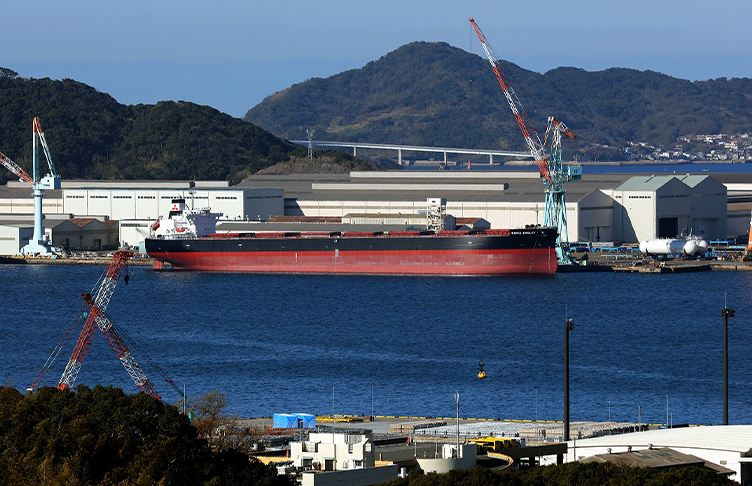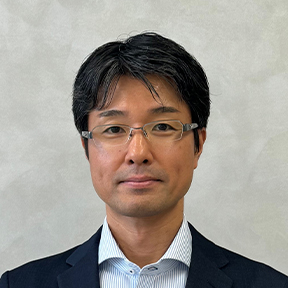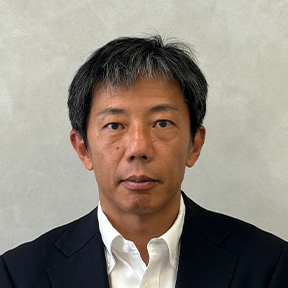2024.10.17

Mitsubishi Ore Transport Co., Ltd. Launches Navigation of the New Bulk Carrier, Santa Embley, Aiming to Achieve Net Zero GHG Emissions by 2050

SANTA EMBLEY
Mitsubishi Ore Transport Co., Ltd. introduced a new bulk carrier in March 2024 for its trade with overseas resource corporate giants. What is the current status of environmental measures in the shipping industry?
Mitsubishi Ore Transport Co., Ltd. started navigation of a newly built bulk carrier, the
SANTA EMBLEY, in March 2024. The vessel is designated for the company’s trade with overseas
resource giants under long-term contracts, transporting resources in bulk (in an unpacked
state). It has an overall length of 229 meters, and a deadweight, or loading capacity (total
weight of the vessel loaded with cargo minus the weight of the vessel itself) of 87,000
tons, as a medium-sized ship. Large vessels generally weigh from 180,000 to 300,000 tons.
The SANTA EMBLEY is the 14th vessel among those owned and managed by the company. Hiroshi
Miura, General Manager of the company's Corporate Planning Office, says, “The new vessel is
equipped with the latest environmental performance and incorporates the company’s various
know-how cultivated over the years in terms of long-term ownership, efficient onboard
operations, and safety. All of these efforts are for the purposes of ensuring the safety and
human rights protection of sailors, improving the satisfaction of shippers and ship users,
who are our customers, and reinforcing our initiatives for safety, the environment, and
quality assurance in line with the SDGs.”
The SANTA EMBLEY mainly transports bauxite, a raw material for aluminum, from Australia, the
supplier, to China, who purchases it. There is growing demand in China for bauxite as an
environmentally friendly material to be used for EVs and other purposes.
With this vessel as the starting basis, the company will continue to harness conventional
technologies while introducing new technologies such as alternative fuels in tandem, in a
bid to achieve net-zero GHG emissions by 2050, the target of the NYK Line Group and the
industry as well.
Shipping industry seeks new types of fuel to be used in place of heavy oil by 2030
The international shipping industry’s current goal is to achieve net zero GHG emissions by
2050. Ships have basically been fueled by heavy oil, but the shipping industry is now at the
stage of seeking new types of fuel that can replace heavy oil, such as liquefied natural gas
(LNG) and methanol in the current transition period toward the target to be achieved by
2050, or hydrogen and ammonia as zero-emission fuels for the future beyond.
“The life of a ship is about 15 to 20 years. Unless we decide on new types of fuel by 2030
at the latest, we will not be able to achieve the goal by 2050. Nevertheless, the
industry-wide direction for the future fuel mainstay is still unclear,” said Miura.
Against this backdrop, the company's newly built bulk carrier, the SANTA EMBLEY, is not
pushing ahead with efforts to adopt new types of fuel, but instead uses conventional heavy
oil in a way that minimizes its consumption, making a head start in complying with the EEDI
phase 3 regulations that will apply to ships under contracts from 2025 onward. The vessel’s
fuel efficiency is about 30% better than the standard value, and a growing number of ships
have been taking measures likewise across the industry over the past few years. Japan-built
ships are leading the world with their high-level environmental performance, and the SANTA
EMBLEY is the latest vessel that boasts the best fuel efficiency in the industry
today.
“We also hope to introduce zero-emission vessels in the future.
However, fuel supply chains and related technology take a long time to be established, so we
decided to introduce a state-of-the-art heavy oil fueled vessel as a GHG reduction measure,
to ensure a certain effect at this point,” said Miura.
Company’s strength: Integrated operation of company-owned vessels, from management to maintenance
Let me share with you a brief input on the background of the shipping industry. Japan's
shipbuilding technology is currently among the best in the world. At the same time, momentum
toward environmental measures is accelerating. Building a ship typically takes about one
year, but often ends up taking at least two to three years after the order is placed because
shipyards tend to fill their construction schedules far in advance. Consequently,
environmental measures implemented by ships are always behind the most recent requirements.
More than 90% of logistics around the world is based on marine transportation. Vessels can
carry large amounts of goods, with less environmental load per unit of goods. Large bulk
carriers mainly carry iron ore and coal, while medium-sized vessels typically carry wheat,
corn, and other grains in addition to iron ore and coal. Iron ore, coal, and grains are
referred to as the three major types of cargo. At the same time, small vessels weighing less
than 60,000 tons can easily enter ports and make turns in small areas, and therefore carry
all kinds of cargo, including minor mineral resources and iron scrap.
The shipping industry has a common practice of leasing vessels and dividing labor among
companies. On the other hand, Mitsubishi Ore Transport Co., Ltd. deals directly with the
world's leading resource and grain trading companies, manages its own vessels, and handles
everything from crewing to maintenance in-house, which distinguishes itself from the rest.
The company’s direct control bears more effective results in safety, the environment, and
quality assurance. Fumiyuki Yasuda, Director of the company's Ship Management Group, says,
“We check every detail from the design drawing phase before the building of a new ship
starts, and send our staff to the construction site once the building phase launches to
check on the ship to the last detail. All ships may look the same, but our ships have fewer
problems after they are completed because we pay close attention to every detail throughout
the entire process, ensuring that there are no defects.”
Establishing a system to promptly respond to any technological innovation
The shipping industry is susceptible to changes in the economy. Many shipping companies
order vessels when transportation demand is high in a booming economy. As a result, when
those ships are completed several years later, the number of vessels becomes excessive
across the industry, often leading to a recession. In addition, during a strong economy,
vessels with high service quality are difficult to procure from the spot market. However,
building a new vessel requires two to three years, so it is crucial to always run a business
based on long-term demand forecasts.
One recent example of such a case is when China experienced explosive demand growth for
vessels before the 2008 financial crisis. Vessels were ordered in large quantities, and the
peak of construction came around 2010 to 2012. The shipping market trend then fell sharply
between 2014 and 2016. Following this, the volume of ship construction declined for a while,
resulting in today’s supply-demand equilibrium between the number of ships and
transportation demand. Going forward, the company is keeping a close eye on India's economic
growth.
Mitsubishi Ore Transport Co., Ltd. always aims to provide sustainable services based on
safety, the environment, and quality assurance. Miura describes the company's future
environmental initiatives as follows.
“We are currently in a transition period on the way to the establishment of zero-emission
fuels. Various alternative fuels are being devised, but the technologies for using ammonia
and hydrogen as fuels have not been established. Therefore, our company is currently
investing up-front in technological research for using LNG and other fuels, as well as in
crew training. Industry-wide technological development is also underway, and I wish to take
on the challenge of developing wind-powered vessels. We will continue to establish a system
that allows us to respond to any technological innovation whenever it emerges.”
INTERVIEWEES

HIROSHI MIURA
General Manager, Corporate Strategy & Planning Dept.

FUMIYUKI YASUDA
General Manager / Fleet Management Group Head of Procurement Team
Mitsubishi Ore Transport Co., Ltd.
3-4-1 Marunouchi, Chiyoda-ku, Tokyo
Established in 1959 as a joint-stock company owned by Mitsubishi Corporation, Mitsubishi Mining Co., Ltd. (now Mitsubishi Materials Corporation), and others to transport Atacama iron ore from Chile to Yawata Iron & Steel Co., Ltd. (now Nippon Steel Corporation). The company changed its name to Mitsubishi Ore Transport Co., Ltd. in 1964. Centering around ship owning and ship management businesses, the company operates a fleet of 14 vessels, including bulk carriers and car carriers. The company is capitalized at 1.5 billion yen and has 43 employees (including Japanese maritime engineers, as of April 1, 2024.) In April 2023, the company became a wholly owned subsidiary of NYK Line Co., Ltd.
